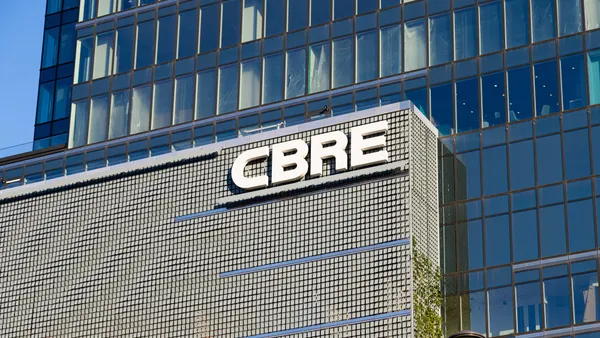Dive Brief:
- Cushman & Wakefield reported a decline in its property, facilities and project management revenue in the first quarter of 2024. Revenue from its leasing business, however, rose marginally, driven by “broad strength across segments,” according to its earnings release Monday.
- The company’s property, facilities and project management business, renamed as services, dropped 3% year over year to $871.2 million in the first quarter, while leasing revenue increased 5% year over year to $381.7 million, the company said.
- “Looking at the big picture, the year is generally progressing in line with expectations,” Cushman & Wakefield CEO Michelle MacKay said on an earnings call Monday. “We expect that leasing, which is a particular strength of ours, will continue to benefit from global economic resiliency as we move through the cycle and our diverse platform allows us to capture pockets of strength across regions and asset classes.”
Dive Insight:
Cushman & Wakefield’s total revenue for the first quarter fell 3% year over year to $2.18 billion, at least partly due to the 3% revenue decline in its services segment. The company said the decline in total revenue was driven primarily by the Americas, due to changes in client mix.
Fee revenue for the Americas services segment, which accounted for 54% of the region’s revenue in the last twelve months, shrank 5% year over year to $599.4 million, according to the company’s earnings presentation.
On the earnings call, Cushman & Wakefield CFO Neil Johnston announced that the company has renamed its property, facilities and project management service line to services, effective Jan. 1, 2024. “This changes in name only and had no impact on the composition of our service lines or our historical results,” Johnston clarified.
Leasing fee revenue accounted for 31% of revenue over the last twelve months and grew 1% year over year to $299.5 million in the first quarter, the company said in its earnings presentation.
MacKay acknowledged that recent interest rate volatility, in response to the Federal Reserve’s rate cuts, may cause a pause in transaction volumes in the second quarter, but expressed confidence in the solid global investment sales pipelines.
Johnston noted that the company’s first-quarter results exceeded management’s expectations and guidance with $1.5 billion in fee revenue, flat compared with the prior year, and $78 million in adjusted earnings before interest, taxes, depreciation and amortization, reflecting a 29% increase year over year. “Overall, we are pleased with the momentum we are seeing in services,” Johnston said.
Cushman & Wakefield’s leasing business continues to “experience stabilizing trends,” Johnston noted, with the Americas region growing 1% year over year, and larger increases of 10% in the Asia-Pacific region and 30% in Europe, the Middle East and Africa. The firm saw “particular strength in mid-sized office and industrial leasing,” across the Americas, with growth in each of the company’s sub-regions for the first time since the fourth quarter of 2022, Johnston said. “In the Americas, we experienced a pickup in pipeline conversion early in the quarter, particularly in office transactions, as interest rates were relatively stable,” Johnston added.
While larger deals in higher-quality Class A trophy buildings predominantly drove leases in the fourth quarter of 2023, the company has seen a shift in the first quarter of this year. “We’re starting to see a mix-in of smaller tenants, still in high quality buildings, but smaller leases in the first quarter of this year,” MacKay said.
The company’s overall adjusted EBITDA margin of 5.2%, measured against its service line fee revenue, rose 117 basis points year over year. Johnston attributed margin expansion across the Americas to strong leasing growth and the company’s 2023 cost actions.
“In the first quarter, we had $20 million of savings, which did more than offset the cost increases we saw,” Johnston said. “If we look at that margin improvement, it was essentially half-driven by these cost savings, and the other half [was] driven by the improvement in … the flow-through up-leasing.”
Johnston reiterated expectations that the company’s cost efficiency initiatives would mostly offset these cost headwinds.
“We continue to expect cost increases driven by normal inflation and high incentive [compensation], as we focus on positioning the company for market growth,” Johnston said. “While our focus on margin and accretive growth is resulting in some near-term revenue headwinds, we expect to see a reacceleration of growth in the second half of this year and a return to at least a mid-single-digit growth rate in 2025.”
Johnston cited expectations of a “relatively stable” leasing market for the year and a growth in its services business at a rate similar to that seen in 2023.















